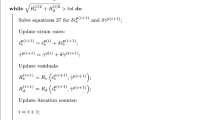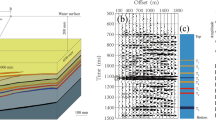Abstract
We present a tool for coupling thermochemistry with mechanics. Thermodynamic potential functions are used to calculate reversible material properties such as thermal expansion coefficient, specific heat, elastic shear modulus, bulk modulus and density. These material properties are thermodynamically self consistent. Transport properties such as thermal conductivity (diffusivity) and melt viscosity are also included, but these are derived from laboratory experiments. The transport properties are included to provide a reference database as a common standard of material properties necessary for comparing geological, geodynamic and geotechnical calculations. We validate the chemically derived elastic material properties by comparing computed seismic velocities for a pyrolitic composition to the seismic models PREM and ak135.





Similar content being viewed by others
References
Behn MD, Kelemen PB (2003) Relationship between seismic P-wave velocity and the composition of anhydrous igneous and meta-igneous rocks. Geochem Geophys Geosyst 4(5):1–57
Bina CR (1991) Mantle discontinuities. Rev Geophys 29:783–793
Bina CR (1998) Mantle mineralogy—Olivine emerges from isolation. Nature. 392(6677):650–+
Bina CR (1998) A note on latent heat release from disequilibrium phase transformations and deep seismogenesis. Earth Planets Space 50(11–12):1029–1034
Bina CR, Wood BJ (1987) Olivine-spinel transitions—experimental and thermodynamic constraints and implications for the nature of the 400-Km seismic discontinuity. J Geophys Res-Solid 92(B6):4853–4866
Cammarano F, Goes S, Vacher P, Giardini D (2003) Inferring upper-mantle temperatures from seismic velocities. Phys Earth Planet Int 138(3–4):197–222
Clauser C, Huenges E (1995) Thermal conductivity of rocks and minerals in rock physics and phase relations—a handbook of physical constants, A.R.S. 3, Editor
Connolly JAD (1990) Multivariable phase-diagrams—an algorithm based on generalized thermodynamics. Am J Sci 290(6):666–718
Connolly JAD (2005) Computation of phase equilibria by linear programming: a tool for geodynamic modeling and its application to subduction zone decarbonation. Earth Planet Sci Lett 236(1–2):524–541
Connolly JAD, Kerrick DM (2002) Metamorphic controls on seismic velocity of subducted oceanic crust at 100–250 km depth. Earth Planet Sci Lett 204(1–2):61–74
Connolly JAD, Petrini K (2002) An automated strategy for calculation of phase diagram sections and retrieval of rock properties as a function of physical conditions. J Metamorph Geol 20(7):697–708
Deschamps F, Trampert J (2004) Towards a lower mantle reference temperature and composition. Earth Planet Sci Lett 222(1):161–175
Deuss A, Redfern SAT, Chambers K, Woodhouse JH (2006) The nature of the 660-kilometer discontinuity in Earth’s mantle from global seismic observations of PP precursors. Science 311(5758):198–201
Duffy TS, Anderson DL (1989) Seismic velocities in mantle minerals and the mineralogy of the upper mantle. J Geophys Res-Solid 94(B2):1895–1912
Dziewonski AM, Anderson DL (1981) Preliminary reference earth model. Phys Earth Planet Int 25(4):297–356
Ghiorso MS, Sack RO (1995) Chemical mass-transfer in magmatic processes. 4. A revised and internally consistent thermodynamic model for the interpolation and extrapolation of liquid-solid equilibria in magmatic systems at elevated-temperatures and pressures. Contrib Mineral Petrol 119(2–3):197–212
Grand SP (2002) Mantle shear-wave tomography and the fate of subducted slabs. Philoso Trans Royal Soc Lond Ser Math Phys Eng Sci 360(1800):2475–2491
Hart SR, Zindler A (1986) In search of a bulk-earth composition. Chem Geol 57(3–4):247–267
Holland T, Powell R (1998) An internally consistent thermodynamic data set for phases of petrological interest. J Metamorph Geol. 16:309–343
Hoschek G (2004) Comparison of calculated P-T pseudosections for a kyanite eclogite from the Tauern Window, Eastern Alps, Austria. Eur J Miner 16(1):59–72
Hui H, Zhang Y (2007) Toward a general viscosity equation for natural anhydrous and hydrous silicate melts. Geochim Cosmochim Acta 71:403–416
Irifune T, Isshiki M (1998) Iron partitioning in a pyrolite mantle and the nature of the 410-km seismic discontinuity. Nature 392(6677):702–705
Irifune T, Ringwood AE (1987) Phase-transformations in a harzburgite composition to 26 Gpa—implications for dynamical behavior of the subducting slab. Earth Planet Sci Lett 86(2–4):365–376
Ita J, Stixrude L (1992) Petrology, elasticity, and composition of the mantle transition zone. J Geophys Res-Solid Earth 97(B5):6849–6866
Karki BB, Stixrude L, Wentzcovitch RM (2001) High-pressure elastic properties of major materials of Earth’s mantle from first principles. Rev Geophys 39(4):507–534
Kennett BLN, Engdahl ER, Buland R (1995) Constraints on seismic velocities in the earth from travel-times. Geophys J Int 122(1):108–124
Khan A, Connolly JAD, Olsen N (2006) Constraining the composition and thermal state of the mantle beneath Europe from inversion of long-period electromagnetic sounding data. J Geophys Res-Solid Earth 111:B10
Klein EM, Langmuir CH (1987) Global correlations of ocean ridge basalt chemistry with axial depth and crustal thickness. J Geophys Res 92:8089–8115
Matas J, Bass J, Ricard Y, Mattern E, Bukowinski MSI (2007) On the bulk composition of the lower mantle: predictions and limitations from generalized inversion of radial seismic profiles. Geophys J Int 170:764–780
Mattern E, Matas J, Ricard Y, Bass J (2005) Lower mantle composition and temperature from mineral physics and thermodynamic modelling. Geophys J Int 160(3):973–990
McKenzie D, Bickle MJ (1988) The volume and composition of melt generated by extension of the lithosphere. J Petrol 29:625–679
Montagner JP, Kennett BLN (1996) How to reconcile body-wave and normal-mode reference earth models. Geophys J Int 125(1):229–248
Ozkahraman HT, Selver R, Isik EC (2004) Determination of the thermal conductivity of rock from P-wave velocity. Int J Rock Mech Miner 41(4):703–708
Plank T, Langmuir CH (1998) The chemical composition of subducting sediment and its consequences for the crust and mantle. Chem Geol 145:325–394
Ringwood AE (1979) Origin of the Earth and Moon. Springer, New York
Ringwood AE (1991) Phase-transformations and their bearing on the constitution and dynamics of the mantle. Geochim Cosmochim Acta 55(8):2083–2110
Rudnick RL, Fountain DM (1995) Nature and composition of the continental crust: a lower crustal perspective. Rev Geophys 33(3):267–309
Saxena SK (1996) Earth mineralogical model: Gibbs free energy minimization computation in the system MgO-FeO-SiO2. Geochim Cosmochim Acta 60(13):2379–2395
Staudigel H, Plank T, White B, Schmincke H-U (1996) Geochemical fluxes during seafloor alteration of the basaltic upper ocean crust: DSDP 417 and 418. In: Bebout GE et al (eds) Subduction: top to bottom, American Geophysical Union Washington, pp 19–38
Stixrude L, Lithgow-Bertelloni C (2005) Mineralogy and elasticity of the oceanic upper mantle: origin of the low-velocity zone. J Geophys Res-Solid Earth 110:B03204
Stixrude L, Lithgow-Bertelloni C (2005) Thermodynamics of mantle minerals—I. Physical properties. Geophys J Int 162(2):610–632
Taylor SR, McLennan M (1985) The continental crust: its composition and evolution: an examination of the geochemical record preserved in sedimentary rocks. Blackwell, Oxford, p 312
Trampert J, Vacher P, Vlaar N (2001) Sensitivities of seismic velocities to temperature, pressure and composition in the lower mantle. Phys Earth Planet Int 124(3–4):255–267
Vacher P, Mocquet A, Sotin C (1998) Computation of seismic profiles from mineral physics: the importance of the non-olivine components for explaining the 660 km depth discontinuity. Phys Earth Planet In 106(3–4):275–298
Watt JP, Davies GF, Oconnell RJ (1976) Elastic properties of composite-materials. Rev Geophys 14(4):541–563
Weidner DJ (1985) A mineral physics test of a pyrolite mantle. Geophys Res Lett 12(7):417–420
Zoth G, Hanel R (1988) Appendix. In: Hanel R, Stegena L, Rybach L (eds) Handbook of terrestrial heat-flow density determination. Kluwer, Dordrecht, pp 449–466
Acknowledgments
This work is a contribution to IGCP 557. The authors would like to acknowledge the support by the Western Australian Government, through the Premiers Fellowship Program and the Minerals Downunder Flagship CSIRO, The University of Western Australia as well as the pmd × CRC.
Author information
Authors and Affiliations
Corresponding author
Rights and permissions
About this article
Cite this article
Siret, D., Poulet, T., Regenauer-Lieb, K. et al. PreMDB, a thermodynamically consistent material database as a key to geodynamic modelling. Acta Geotech. 4, 107–115 (2009). https://doi.org/10.1007/s11440-008-0065-0
Received:
Accepted:
Published:
Issue Date:
DOI: https://doi.org/10.1007/s11440-008-0065-0




